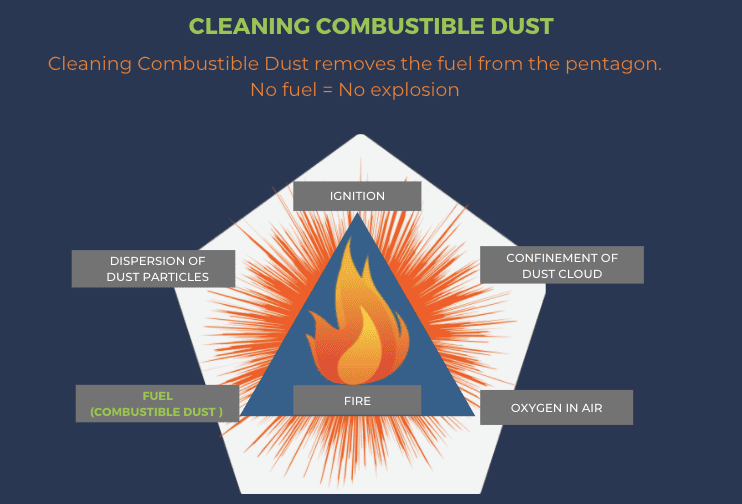Combustible Dust Health & Safety

Subscribe to our Blog
If you are in charge of safety in your manufacturing or industrial plant, the concept of combustible dust health and safety isn’t new to you – especially if you manufacture solid organic materials such as flour, sugar grain or wood. If you’re a newbie to the concept of combustible dust, don’t worry. We’re going to break a few things down for you in the post to bring you up to speed.
What is combustible dust?
Essentially, a combustible dust is any fine material that can catch fire and explode when mixed with air. The Occupational Safety and Health Administration (OSHA) in the United States defines combustible dust as “a solid material composed of distinct particles or pieces, regardless of size, shape, or chemical composition, which presents a fire or deflagration hazard when suspended in air or some other oxidizing medium over a range of concentrations”. Any activity that creates dust should be investigated to see if there is a risk of that dusk being combustible. Dust can collect on surfaces such as rafters, roofs, suspended ceilings, ducts, crevices, dust collectors and other equipment. When the dust is disturbed and under certain circumstances, there is the potential for a serious explosion to occur. The build-up of even a very small amount of dust can cause serious damage.
What types of dust are combustible?
Combustible dusts can be from:
- Most solid organic material such as sugar, flour, grain wood, etc.
- Many metals
- Some non-metallic inorganic materials
Some of these materials are not “normally” combustible, but they can burn or explode if the particles are the right size and the right concentration. OSHA has created a great graphic that breaks down in list form which dusts are combustible. If you work in a manufacturing or industrial plant that, it would be a great idea for you to take a look at this list to familiarize yourself with it.
Is dust accumulation dangerous?
Any activity that creates dust should be investigated to see if there is a risk of that dust being combustible. Dust can collect on surfaces such as rafters, roofs, suspended ceilings, ducts, crevices, dust collectors, and other equipment. When the dust is disturbed and under certain circumstances, there is a potential for a serious explosion to occur. The build-up of even a very small amount of dust can cause serious damage.
Dust accumulates throughout the years, and any small fire or explosion that shakes the dust can cause it to ignite. This phenomenon is dangerous because dust builds up everywhere, and even the smallest amount can cause a deadly explosion under the right conditions. Any combustible material can burn rapidly when in a finely divided form. If such a dust is suspended in air in the right concentration, under certain conditions, it can become explosible. Even materials that do not burn in larger pieces (such as aluminum or iron), given the proper conditions, can be explosible in dust form.
The force from such an explosion can cause employee deaths, injuries, and destruction of entire buildings. For example, 3 workers were killed in a 2010 titanium dust explosion in West Virginia, and 14 workers were killed in a 2008 sugar dust explosion in Georgia. The U.S. Chemical Safety and Hazard Investigation Board (CSB) identified 281 combustible dust incidents between 1980 and 2005 that led to the deaths of 119 workers, injured 718, and extensively damaged numerous industrial facilities.
How do Combustible Dust Explosions Occur?

Any fire needs three elements. These elements are knows as the “fire triangle”.
- Fuel to burn
- Oxygen
- Ignition source (heat, spark. etc.)
A dust explosion, however, needs two addition elements – the dispersion of dust particles in the right quantity and concentration and confinement of the dust cloud. Together, these five elements can cause rapid combustion known as deflagration. Deflagration is a term often used to describe combustible dust explosions. A deflagration is an “ordinary” fire such as a gas stove, burning wood or paper, and even the burning of gasoline vapor inside the cylinder of an automobile. In a deflagration, a burning substance releases heat, hot gases, and energetic particles or sparks that ignite and spread the fire. These five factors are known as the Dust Explosion Pentagon, as shown above.
The basic requirements for a dust explosion to occur is that combustible dusts are suspended in air and are ignited. In practice, for a dust explosion to occur, a number of conditions must be met. These conditions include:
- The dust must be combustible and release enough heat when it burns to sustain the fire.
- The dust must be capable of being suspended in air.
- The concentration of the dust suspension must be within the explosible range.
- An ignition source must be in contact with the dust suspension.
- The atmosphere must contain sufficient oxygen to support and sustain combustion.
- There is a form of confinement or enclosure that allows pressure to build.
Ready to learn more about the Codes and Standards that mandate combustible dust and to learn more about how to mitigate the risk in your manufacturing or industrial facility? Consider our Combustible Health & Safety Course that breaks it all down for you. Still not sure? Contact us or our sister company, Hughes Environmental. If you have an issue with combustible dust, we are certain we have a solution for you.





